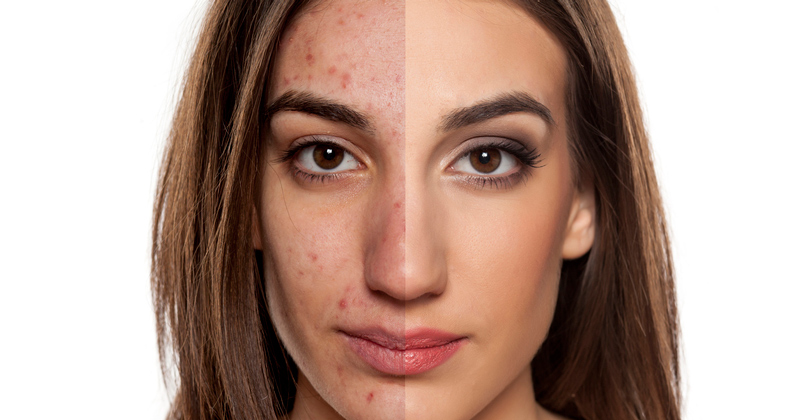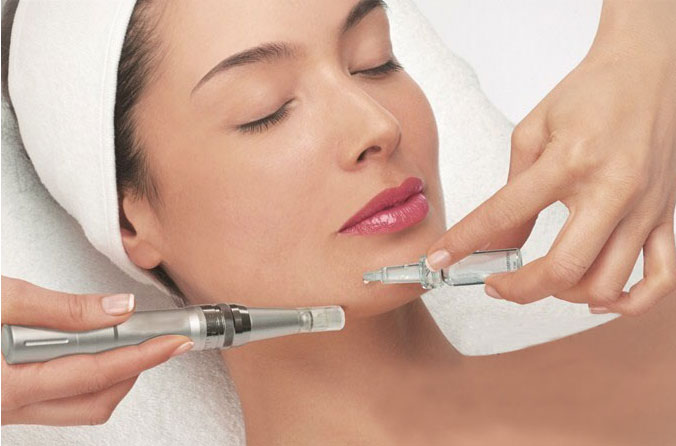
What is Microneedling?
Microneedling, also known as collagen induction therapy, is a minimally invasive skin rejuvenation procedure that helps minimize the signs of aging, improve the appearance of acne scars and rejuvenate aging skin. A microneedling device causes controlled micro-injuries that stimulate the body’s natural wound healing process. The micro-injuries trigger the release of cytokines and growth factors that lead to remodeling of collagen and elastin.
How does Microneedling Work?
Small needles are used to create microscopic channels in the skin and the surrounding area stays intact. These micro purferations gives the skin the opportunity to react as if it were injured, this stimulates collagen production. These micro purferations also supports the penetration of a special serum during the treatment for added anti-aging benefit. During the healing process of the micro injuries, the top skin layer is also renewed, giving the skin a more youthful appearance.
What is the wound repair process?
- Phase I: Inflammation. Piercing the skin triggers your immune system to disinfect the wounds, remove debris, increase blood flow and begin to create new tissue.
- Phase II: Proliferation. The wound is re-built with new granulation cells, as well as a temporary (type III) collagen and elastin, which are part of the extracellular matrix. Additionally, a new network of blood vessels develops.
- Phase III: Remodeling. The wound has been replaced with new dermal tissues and blood vessels. The type III collagen in the newly formed tissue is replaced with stronger type I collagen, which can contract to create a tightening or “shrink wrap” effect on the skin.
The total healing time depends on each individual. Most patients have some slight swelling and redness/pinkness (like a mild to moderate sunburn) for two to four days following the microneedling procedure. Some people may see their skin return to normal in about 24 hours.
FAQ
Microneedling stimulates healing by causing a controlled injury to the skin. Upon first thought, it defies reason that hurting our skin can actually make it look better. But aesthetic medicine has proven this is actually the case. In fact, the medical aesthetic industry has been built on this premise.
The general rule of thumb is, the more invasive the treatment, the more dramatic the results. Case in point, if you get a facial – you will see a luminous glow for a few days afterward. But if you get a Microneedling treatment, you will keep that luminous glow for four to six weeks.
Microneedling is known to naturally smooth, tighten and target aging areas of the face and body. Microneedling treats and prevents wrinkles, aging skin, surgical and hypertrophic scars, stretch marks, acne and pitted scars, sagging skin, hyperpigmentation, UV damage, Rosacea, and Melasma.
Treating skin conditions such as Melasma and Rosacea with Microneedling can be highly effective. If you suffer from either of these similar skin conditions, you already know there are very few ways to effectively treat your skin discoloration concerns. Microneedling combined with SkinMedica Lytera Skin Brightening Complex is the most effective in-office treatment we prescribe for our Melasma and Rosacea clients.
After your skin has received the Microneedling treatment, we will apply the SkinMedica Lytera Skin Brightening Complex to the treated skin on your face. This product contains skin brightening ingredients as well as Vitamin C, Vitamin B3, Essential fatty acids, retinol, and algae.
You will see an improvement in the overall condition of your skin, improved skin tone, and reduced discoloration of your skin.
First your face is thoroughly cleansed with a topical cleanser. Then a topical anesthetic is applied to your skin for 30 minutes before your treatment. When the treatment begins, a serum will be applied to your skin to help the MicroPen gently glide over your skin. The needling itself typically feels like a slight vibration, and almost like a massage with tingling on your skin. During the collagen induction process, the tiny needles in the MicroPen will penetrate through your skin, but will not remove it. Since your skin will only be punctured, it will heal quickly.
Your skin might lightly bleed but only for a few seconds. The mini-punctures will trigger the production of your very own growth factors that eventually result in collagen production. New collagen production can be further increased by the use of boosters such as PRP, hyaluronic acid, SkinMedica TNS Serum. You can expect your Microneedling treatment to take about one hour. Your skin will be red for less than an hour for darker skin tones and several days for lighter, more sensitive skin.
You should expect erythema and edema to the treated area. This will subside within a day or two. Tiny pinpoint scabs will appear 24-72 hours post-treatment and may remain 3-7 days following. The scabs should not be touched, itched or exfoliated. They will naturally shed off when ready. During the next 48 hours post-treatment, you should avoid working out, hot showers, massages, and sun exposure.
Do not apply makeup to your skin for 12 hours after treatment while your skin is healing. You may start applying emollient creams to alleviate any dry, tight or itchy sensations while your skin is healing. Do not shave for 1-2 days post treatment while your skin is healing. You should apply high-factor sunscreen (at least 30 SPF) and protect the treated area from sunlight. Sun exposure may cause hyperpigmentation.
We have younger Microneedling clients with acne scars and more mature Microneedling clients with sun damage and wrinkles. Microneedling results are naturally beautiful, and it’s also a chemical free treatment in which no foreign substances are injected. Your skin will become thicker. Collagen and elastin will increase up to 1000 percent. Any part of the body may be treated and Microneedling is safe for darker skin tones.
In other treatments involving ablative or heat methods, cicatricial healing is triggered, and type I collagen forms from the top down in the dermal layer. The major benefit of Microneedling is the growth factors released trigger regenerative healing. This type of healing is comprised of type III collagen forming from the base upwards in the dermal layer.
Microneedling will combat a variety of common skin care concerns, including scarring, stretch marks, melasma, and more. The results are smoother, thicker, tighter, more even-toned skin. The phases of collagen induction include:
- Inflammation begins immediately during your treatment.
- An Inflammatory Response will trigger tissue generation. Your very own natural growth factors will cause your body to produce healthy tissue.
- New tissue Formation will continue for up to 1-year post treatment.Treatments vary depending on skin conditions but we typically recommend between 3-6 sessions with 4-6 weeks in between sessions and then touch ups once or twice a year after that.



